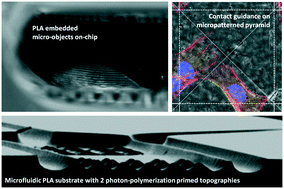Our official English website, www.x-mol.net, welcomes your
feedback! (Note: you will need to create a separate account there.)
Development of a microfluidic platform integrating high-resolution microstructured biomaterials to study cell–material interactions
Lab on a Chip ( IF 6.1 ) Pub Date : 2017-10-27 00:00:00 , DOI: 10.1039/c7lc00802c D. Barata 1, 2, 3, 4, 5 , E. Provaggi 1, 2, 3, 4, 5 , C. van Blitterswijk 1, 2, 3, 4, 5 , P. Habibovic 1, 2, 3, 4, 5
Lab on a Chip ( IF 6.1 ) Pub Date : 2017-10-27 00:00:00 , DOI: 10.1039/c7lc00802c D. Barata 1, 2, 3, 4, 5 , E. Provaggi 1, 2, 3, 4, 5 , C. van Blitterswijk 1, 2, 3, 4, 5 , P. Habibovic 1, 2, 3, 4, 5
Affiliation

|
Microfluidic screening platforms offer new possibilities for performing in vitro cell-based assays with higher throughput and in a setting that has the potential to closely mimic the physiological microenvironment. Integrating functional biomaterials into such platforms is a promising approach to obtain a deeper insight into the interactions occurring at the cell–material interface. The success of such an approach is, however, largely dependent on the ability to miniaturize the biomaterials as well as on the choice of the assay used to study the cell–material interactions. In this work, we developed a microfluidic device, the main component of which is made of a widely used biocompatible polymer, polylactic acid (PLA). This device enabled cell culture under different fluidic regimes, including perfusion and diffusion. Through a combination of photolithography, two-photon polymerization and hot embossing, it was possible to microstructure the surface of the cell culture chamber of the device with highly defined geometrical features. Furthermore, using pyramids with different heights and wall microtopographies as an example, adhesion, morphology and distribution of human MG63 osteosarcoma cells were studied. The results showed that both the height of the topographical features and the microstructural properties of their walls affected cell spreading and distribution. This proof-of-concept study shows that the platform developed here is a useful tool for studying interactions between cells and clinically relevant biomaterials under controlled fluidic regimes.
中文翻译:

开发集成高分辨率微结构生物材料的微流体平台,以研究细胞与材料之间的相互作用
微流体筛选平台为体外执行提供了新的可能性基于细胞的分析,具有较高的通量,且设置的环境可能紧密模拟生理微环境。将功能性生物材料整合到这样的平台中是一种很有前途的方法,可以更深入地了解细胞-材料界面处发生的相互作用。然而,这种方法的成功很大程度上取决于使生物材料小型化的能力以及用于研究细胞与材料相互作用的分析方法的选择。在这项工作中,我们开发了一种微流体装置,其主要部件由广泛使用的生物相容性聚合物聚乳酸(PLA)制成。该装置使细胞能够在不同的流体状态下进行细胞培养,包括灌注和扩散。通过光刻,双光子聚合和热压花的组合,可以使用高度定义的几何特征对设备的细胞培养室表面进行微结构化。此外,以具有不同高度的金字塔和壁微形貌为例,研究了人MG63骨肉瘤细胞的粘附,形态和分布。结果表明,地形特征的高度和其壁的微观结构特性都影响细胞的扩散和分布。这项概念验证研究表明,此处开发的平台是研究细胞与临床相关生物材料在受控流体状态下相互作用的有用工具。以不同高度的金字塔和壁微形貌为例,研究了人MG63骨肉瘤细胞的粘附,形态和分布。结果表明,地形特征的高度和其壁的微观结构特性都影响细胞的扩散和分布。这项概念验证研究表明,此处开发的平台是研究细胞与临床相关生物材料在受控流体状态下相互作用的有用工具。以不同高度的金字塔和壁微形貌为例,研究了人MG63骨肉瘤细胞的粘附,形态和分布。结果表明,地形特征的高度和其壁的微观结构特性都影响细胞的扩散和分布。这项概念验证研究表明,此处开发的平台是研究细胞与临床相关生物材料在受控流体状态下相互作用的有用工具。
更新日期:2017-11-08
中文翻译:

开发集成高分辨率微结构生物材料的微流体平台,以研究细胞与材料之间的相互作用
微流体筛选平台为体外执行提供了新的可能性基于细胞的分析,具有较高的通量,且设置的环境可能紧密模拟生理微环境。将功能性生物材料整合到这样的平台中是一种很有前途的方法,可以更深入地了解细胞-材料界面处发生的相互作用。然而,这种方法的成功很大程度上取决于使生物材料小型化的能力以及用于研究细胞与材料相互作用的分析方法的选择。在这项工作中,我们开发了一种微流体装置,其主要部件由广泛使用的生物相容性聚合物聚乳酸(PLA)制成。该装置使细胞能够在不同的流体状态下进行细胞培养,包括灌注和扩散。通过光刻,双光子聚合和热压花的组合,可以使用高度定义的几何特征对设备的细胞培养室表面进行微结构化。此外,以具有不同高度的金字塔和壁微形貌为例,研究了人MG63骨肉瘤细胞的粘附,形态和分布。结果表明,地形特征的高度和其壁的微观结构特性都影响细胞的扩散和分布。这项概念验证研究表明,此处开发的平台是研究细胞与临床相关生物材料在受控流体状态下相互作用的有用工具。以不同高度的金字塔和壁微形貌为例,研究了人MG63骨肉瘤细胞的粘附,形态和分布。结果表明,地形特征的高度和其壁的微观结构特性都影响细胞的扩散和分布。这项概念验证研究表明,此处开发的平台是研究细胞与临床相关生物材料在受控流体状态下相互作用的有用工具。以不同高度的金字塔和壁微形貌为例,研究了人MG63骨肉瘤细胞的粘附,形态和分布。结果表明,地形特征的高度和其壁的微观结构特性都影响细胞的扩散和分布。这项概念验证研究表明,此处开发的平台是研究细胞与临床相关生物材料在受控流体状态下相互作用的有用工具。











































 京公网安备 11010802027423号
京公网安备 11010802027423号